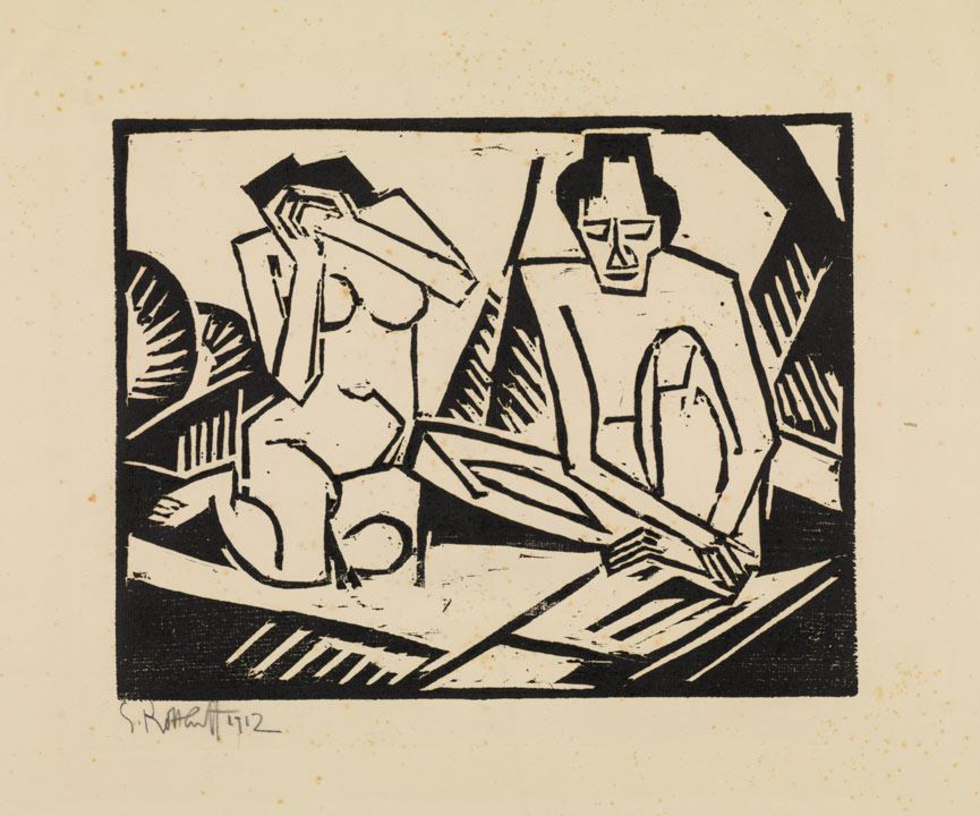Utopia, Depravity and Trauma: German Revolution Expressionist Prints – Reviewed

Art, to be relevant, must say something about the times in which it was created. In between lockdowns, Flora Zajicek made for an exhibition of prints at the Lady Lever Art Gallery, to find what the German Expressionists had to say about the interwar Weimar period…
With my art historian goggles on, walking around this exhibition of Expressionist prints is like entering a posh deli with a limitless gift card. The delicacies include Picasso’s Le Repas Frugal, Munch’s In the Male Brain, and Egon Schiele’s Sorrow, the only print by Schiele held in a British public collection. With my empathetic human goggles on, it is a deeply affecting show that demonstrates the idiosyncrasies of individual artistic reactions to great trauma and the sometimes disturbing polarities of experience of Weimar Germany, oscillating between utopic scenes of peace, sexually charged depravity and extreme poverty, destruction and loss.
The works, as is only correct, take centre stage in this show as the curators step back, offering interpretation on each print, but not attempting to provide too much of a weighty narrative of this complex and turbulent period of German history. It is a slight misnomer to title it German Revolution as the exhibition includes works spanning about 40 years, from before the turn of the century right up until the late thirties. And while it is right to pull out threads of themes, it would be an impossible task in one small exhibition to tell how these artists all relate to one another in their various secessions and avant-garde groups. German Expressionism is so rich for just that, it encompasses an historically specific set of anxieties and sentiments more than a single artistic style or language; demonstrating the wide range of artistic reactions and interventions in this period.
Comprised mainly of lithographs, woodblock prints and drypoint etchings, we get to see how artists such as Max Beckmann, Karl Schmidt-Rotluff (top), George Grosz and Käthe Kollwitz conveyed the emotional weight of life around them. In Grosz’s 1920 work Fit for Garrison Duty, we get a taste of his cynical wit, as he points out the hypocrisies and corruption of all strata in German society. Here we see an old soldier approaching us, balls sagging through his breeches with a neck as thick as his head like a prize bull at a fair – a far cry from something like Max Beckmann’s The Martyrdom of one year earlier. In this disturbing lithograph, you’ll see Rosa Luxembourg, a revolutionary leader who was killed as part of the brutal suppression of the socialist uprising, arms outstretched being carried away by soldiers who jab and taunt her with their rifles, grope her breasts and laugh demonically.
Elsewhere, Otto Dix’s Acrobats (1921) turns our gaze towards people from the entertainment industry during the interwar period, in all its sordid glitz; the woman looking at us, breasts bulging out of her corset and the wonderful detail of a flaming heart tattoo on her thigh. Away from the dancing, sex and jazz, we then get Kollwitz’s deeply affecting portraits of the emaciated poor. Despite such abject scenes, it was good to see so much Kollwitz and other female artists taking their rightful place in this exhibition, with the inclusion of Paula Modersohn-Becker and Gabriele Münter. Their works provided crucial insight into the reality of female experiences from female perspectives, rather than the sometimes-reductive depictions of women by their male counterparts.
While there was no doubt much to recommend it, I was left disappointed by the exhibition’s failure to properly handle the issue of cultural appropriation. It was acknowledged that many of the artists who travelled to Palau in Micronesia, an archipelago in the Western Pacific Ocean (and a German colony at the time), produced “idealised images that do not reflect the harsh struggle of the local population to survive in the face of the impact of long-term colonial rule.” However, more could have been said by way of a critique of the artists’ essentialist interpretation of objects in the Ethnological museums, and their appropriation of a “rough” or “primitive” style. We know by now that, even while this was accepted, even ‘normal’, at the time, it can no longer go unaddressed.
This oversight aside, the exhibition – interrupted by successive lockdowns and now closed – captures a key period, not only of German History, but also of artists grappling with uncertain, often cruel times.
Flora Zajicek
German Revolution Expressionist prints was at Lady Lever Art Gallery, 02 Oct 2020—28 Feb 2021
Main image: Karl Schmidt-Rottluff, Mann und Weib (Man and Wife), 1912, woodcut © DACS 2020





